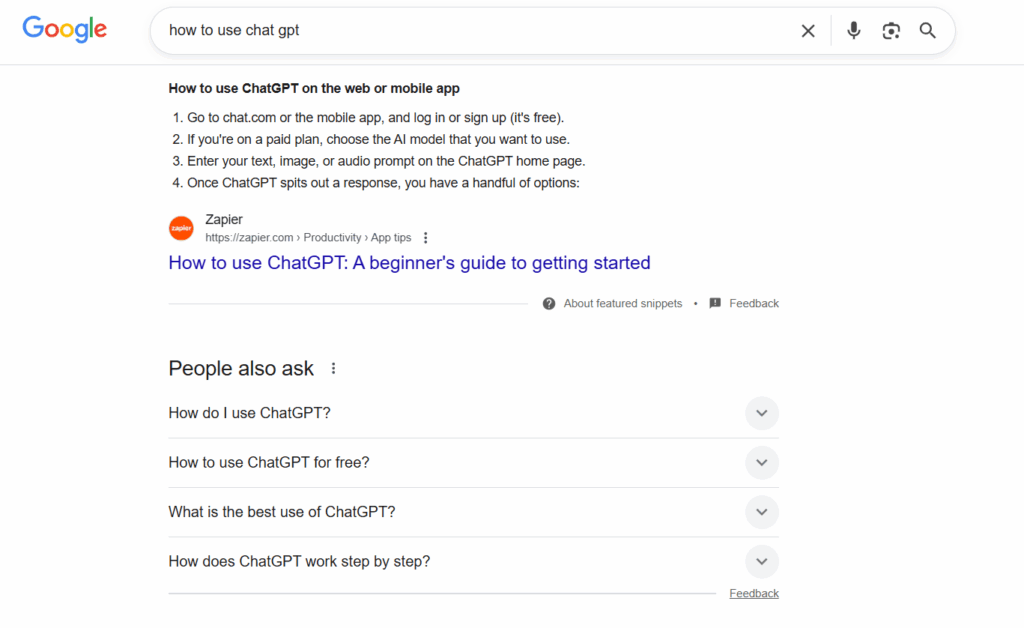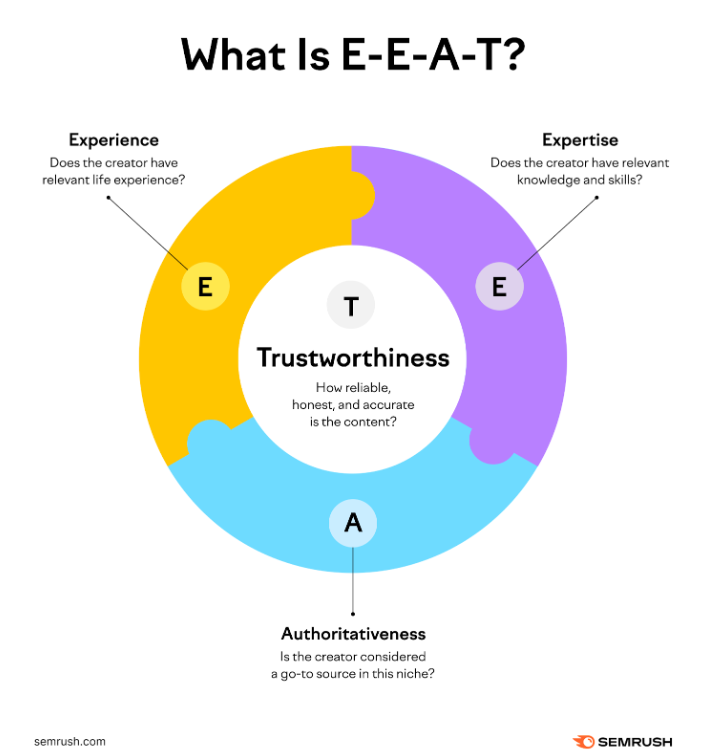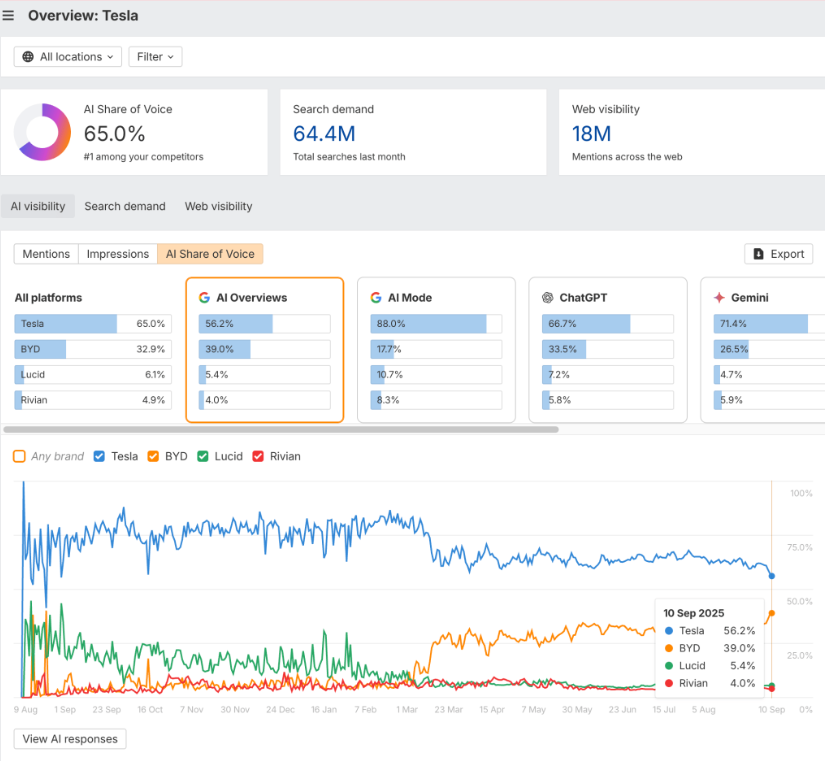Google Search has moved beyond just showing a list of blue links. Today, it aims to deliver quick, smart answers right on the results page. This means users often get what they need without having to click through to a website. Two key features driving this change are Featured Snippets and AI Overviews.
Although both appear at or near the top of search results, they serve different purposes. Understanding how they work and how to tailor your content for each can help you boost your digital presence and establish your brand as an authority.
Featured Snippets vs AI Overviews—The Differences
While Featured Snippets and AI Overviews aim to provide quick answers to users’ queries directly on the search engine results page (SERP), their mechanics, sourcing, and goals are fundamentally different.

Featured Snippets
Featured Snippets, also known as answer boxes, have been around since 2014. They extract a concise piece of content, typically a paragraph, a list, or a table, from a single high-ranking webpage that best answers a specific query. These snippets answer clear, straightforward questions quickly and are presented in what is commonly called “position zero,” above all organic results.

Why it works: Featured Snippets give users quick access to answers without scrolling through multiple pages. For marketers, specifically web marketing SEO specialist, landing a snippet drives higher visibility and click-through rates (CTR). Even when searchers skim results fast, snippets can catch their attention and lead them to your site.
AI Overviews
AI Overviews are newer, introduced in 2024 as part of Google’s Search Generative Experience. Instead of pulling content from one source, they generate responses by synthesizing information from multiple authoritative websites. These answers are more conversational, often interactive, and designed to address multi-layered questions.

Why it works: AI Overviews reflect Google’s push to deliver richer and more complex answers through AI-powered synthesis. They handle complicated questions that need context from various angles. Appearing here boosts your brand’s reputation and signals that you are a trusted source in your field.
Since AI Overviews often take prime spot—at the top of featured snippets and organic search results—being referenced means your content is part of the new gold standard in search.
Optimizing Content for Featured Snippets and AI Overviews
Although each feature rewards slightly different signals, optimizing content for both Featured Snippets and AI Overviews is entirely possible. The common ground is: clear structure, authoritative information, and strong alignment with user intent. Here’s how to build content that appeals to both search mechanisms:
- Clear, Direct Answers
Write short and factual responses, usually 40 to 60 words, that answer common user questions right at the start of a section.
Google prefers crisp definitions because they let people find quick answers. These clear explanations also help AI tools recognize your content as trustworthy when they generate AI summaries.
- Structured Formatting
Organize your content with clear headings (H1, H2, H3), bullet points, numbered lists, and tables to make it easy for machines to read.
Featured Snippets require well-structured formatting to select specific excerpts, while AI Overviews utilize that structure to comprehend the context and hierarchy across your page. A well-organized article signals to Google that your content is both understandable and meaningful.
- User Intent Focus
Every part of your content should answer why, what, or how questions that users have.
Featured Snippets mainly show up for clear, straightforward queries, while AI Overviews prefer content that digs deeper and covers related questions and topics.
- E-E-A-T

This image was taken from Semrush.
Google puts a lot of weight on Experience, Expertise, Authoritativeness, and Trustworthiness (E-E-A-T).
Citing reliable sources, showing your author’s knowledge, and including accurate data make your content trustworthy. This is not just good for rankings; it helps AI models rely on your content when generating answers.
- Accessible Language
Write naturally with short paragraphs, simple English, and active voice.
Featured Snippets favor quick, easy answers. Meanwhile, AI Overviews lean toward conversational, easy-to-read text that sounds like how people really talk. Avoid jargon unless you really need it. Clear writing makes your content more likely to be featured or cited.
- Content Depth
AI Overviews reward topical debt and interconnectedness. Google’s AI models analyze multiple related pages to gauge authority across a subject. So, the best practice is to create comprehensive content clusters with strong internal links.
In contrast, Featured Snippets focus on brevity and precision; therefore, it is recommended to provide a complete yet succinct answer in a single section.
- Technical Implementations
Technical SEO plays distinct roles for each Google feature. Featured Snippets benefit from structured data such as FAQ, HowTo, and Article schema. This helps Google understand your content type and increases snippet changes. Meanwhile, AI Overviews rely more on semantic signals, such as related topics, keyword variations, fast-loading pages, and mobile-friendly design to help AI identify and synthesize your content.
Measuring Your Performance
Monitoring your visibility in Featured Snippets and AI Overview can help you gain a complete picture of how your content performs in the new search ecosystem.
Featured Snippet Performance Tracking
Featured Snippets are easier to track because Google flags them clearly. Use the following tools and methods:
- Google Search Console provides clear data on Featured Snippets, including impressions, clicks, and average position.
- Manual SERP Checking helps verify if your content appears as a snippet.
- Third-party SEO Tools like Semrush and Ahrefs offer keyword tracking with alerts for snippet appearances.

This image was taken from Semrush.
Metrics to Watch:
- Impressions: How often your content appears in the snippet position.
- Click-Through Rate (CTR): How many users click through after seeing your snippet.
- Average Position: Your typical ranking position for snippet-triggering queries.
These data points show whether your optimizations are sustaining visibility or whether competitors are starting to replace you.
AI Overview Performance Tracking
Unlike static snippets, tracking AI Overview performance is more complex but still manageable with modern tools and techniques:
- Third-party tools with AI Overview Trackers, such as Semrush, Ahrefs, Keyword.com, and SEO Ranking, now provide specific modules to detect if your content is cited or referenced within AI Overviews. These tools analyze SERP features and citation sources, offering insights into your content’s presence in AI summaries.

This image was taken from Ahrefs.
- GSC helps identify whether your pages are included in any AI Overview citations or sources.
- Manual Keyword Searches, particularly targeted long-tail keyword searches, can reveal if your content is being included in these summaries.
Performance metrics to look into:
- Presence & Position: Whether your pages are featured in AI Overviews
- CTR: Provides insight into user engagement
- Source Citations: The number and quality of source citations linking to your content, indicating authority and presence in AI-driven results.
These metrics show whether your content is gaining exposure and trust, even when users do not always click through.
Bottom Line
The search landscape has changed. Success is now about balancing clear, easy-to-understand content with deep, trustworthy information that both users and AI can trust. Winning at Featured Snippets and AI Overviews means your brand is not just ranking, but has become a go-to resource by Google—recognized and cited on the biggest search stage.
If you want to gain your spot at “Position Zero” and grow your brand’s authority in this era of AI-powered search, expert guidance from a digital marketing specialist in the Philippines can make a difference.
With over 16 years of experience in digital marketing and SEO, I can help you refine your strategies and get your content where it belongs—right at the top!
Contact me today to get started.
References
https://blog.google/products/search/ai-overviews-update-may-2024
https://digitalmarketinginstitute.com/blog/google-ai-overviews-what-do-they-mean-for-search
https://lowfruits.io/blog/featured-snippets/
